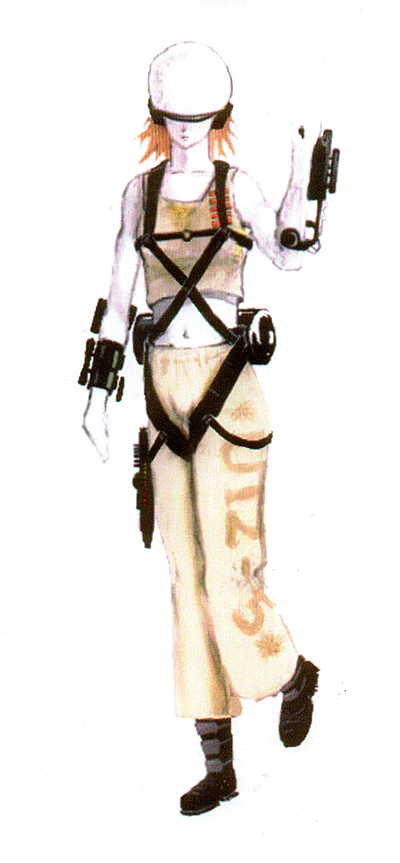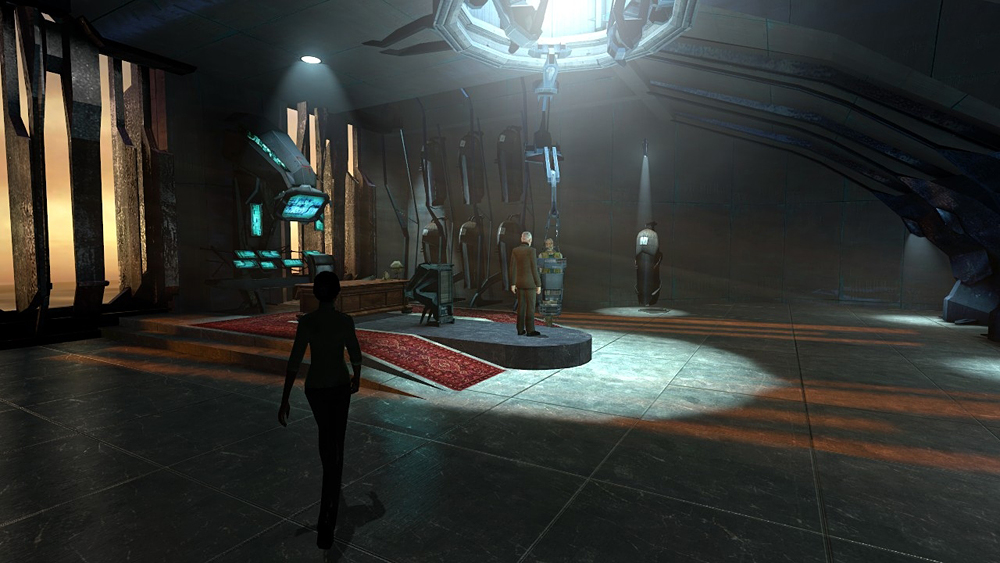 |
| [1] VALVE (1998) Valve Logo [Online Image] Avaliable from: http://semiaccurate.com/assets/uploads/2011/09/valve-logo.png [24/04/2014] |
In August 1996, Newell and Harrington, two retired Microsoft Developers with 30 years under their belts, came together with a love of video games. Settling into an office in a small Seattle suburb of Kirkland, Washington, Valve hired it’s first employees. Taken from the ranks of the Quake Modding community, these young programmers and level designers, the essence of the gaming community, helped to produce one of the most ground breaking games, Half-life. With the licensing of the Quake engine in hand, the team was split into two and each, set forth in their production[3].
 |
| The heroine of Prospero [4] VALVE (1996) The Heroine of Prospero [Online image] Avaliable from: http://img2.wikia.nocookie.net/__cb20100418212431/half-life/en/images/b/b2/Aleph_1.jpg [Accessed 24/04/2014] |
As Quiver started to take over some of the initial goals of Prospero’s, morphing the latter into a Massive Multiplayer game. The game would have a mixture of Valve and user-created worlds, each running on a different server. Other elements for Prospero were concepted, such as online distribution for it, a server browser and a friend finder. These elements were later implimented into Steam, which I’ll be speaking about in depth in later posts. As Prospero mixed with Quiver, it’s atmosphere and narrative was adapted into the game[5].
During the production of Half-Life, the Quake 1 Engine had to be heavily modified, with most of the code being rewritten such as the A.I. and the audio output had to be heavily modified. This became the GoldScr engine[6].
 |
| Half-Life 1, Sector C's Front Desk [7] VALVE (1998) Sector C's Front Desk [Online Image]. Avaliable from: http://cd1.leviathyn.com/wp-content/uploads/2012/05/halflife.jpg [Accessed 24/04/2014] |
Development of Half-life 2 begun in June 1999. Ideas about the sequel involved Gordon fighting the combine forces on Zen, and the version we know, eastern European city setting. Two years later, Newell left the development to work on Steam, allowing the dev team to work by themselves and explore ideas. The following year Newall announced Steam to the public[8].
 |
| Half-life 2, Dr. Breen's office [9] VALVE (2004) Lighting effects in Breen's office from Half-Life 2 [Online Image] Avaliable from: http://img3.wikia.nocookie.net/__cb20090604225421/half-life/en/images/5/5e/Half-Life_2_Dr_Breen_Office.jpg [Accessed 24/04/2014] |
Pressure begun to grow within Valve, since the release of the information, so Newell let the truth out. The leaks had nothing to so with the delay of Half-Life 2, while emitting that the delays was his fault. He was too unrealistic about it’s progress, and the closer they got to the release date the more obvious it was that the game wasn’t going to be finished in time. But later that year, November 16th, we finally got Half-Life 2.
Although I condemn Newell actions in lying about the leaking being the main issue of Half-Life 2’s delay, I can completely understand why he did it. He probably got excited about Half-Life 2 with all of the brilliant work they were putting into it, and so announced an extremely optimistic release date which turned out they couldn’t make. Developers often get abuse, just for making a game or being in the public eye. So saying that the leak affected development time is a legitimate reason for making your fans wait and minimising the amount of abuse. If your game was leaked, changing it would be for the best, as people would have seen the screenshots, and if the game worked, played it. When it came out he lied, the employees at Valve, especially Newell, all would have faced abuse. All of this due to his fear of disappointing the fans and receiving more harassment.
Being transparent in situations like this is the best. By not trying to hid anything from the fans, they will have more respect for you in the long run. You’re fan base will grow. With them knowing your not there to cheat them, they can enjoy your games, instead of going in with a shield up, wondering what you’ve done to ruin their franchise. They are the people who will stand by you. If you have to delay a game to make it better, do that and explain why. Transparency is the best cause, and no matter what you’ll do, expect backlash. Valve now as an amazing reputation for making games, even if we have to wait, we’re not disappointed by them, and of course, Steam with it’s sales. I feel Valve learnt a lesson from this, and that's why we have limited information on Half-Life 3. The team doesn’t want to let us fans down, and so feel it better not to confirm or deny it’s existence.
As I feel like I’ve now rambled on for far too long, I want to leave you with a line that’s stuck with me, said by none other than Gabe Newell in 2004:
“10 years from now, people will look back at Valve and see a company who genuinely cares about the games and the people who play games. We did not cut corners and yeah may never have shipped on time, but at least lived up to it’s responsibilities to moving things forward.”[11]
Biblography
[1] - VALVE (1998) Valve Logo [Online Image] Avaliable from: http://semiaccurate.com/assets/uploads/2011/09/valve-logo.png [24/04/2014]
[2] - CAPRIOLE, A. (2008) The History of Valve [Online] PLANET HALF-LIFE. Available from: http://planethalflife.gamespy.com/View.php?view=Articles.Detail&id=121 [Accessed 23/04/2014]
[3] - HODGSON, D. (2004) Anomalous Materials. In: HODGSON, D. et al. Half-Life 2: Raising the Bar - A Behind the Scenes Look: Prima's Official Insider's Guide. Roseville: Prima Games. pp. 8
[4] - VALVE (1996) The Heroine of Prospero [Online image] Avaliable from: http://img2.wikia.nocookie.net/__cb20100418212431/half-life/en/images/b/b2/Aleph_1.jpg [Accessed 24/04/2014]
[5] - HODGSON, D. (2004) Anomalous Materials. In: HODGSON, D. et al. Half-Life 2: Raising the Bar - A Behind the Scenes Look: Prima's Official Insider's Guide. Roseville: Prima Games. pp. 9 - 11
[6] - BOKITCH, C. (2002) Half-Life Code Basis [Online] VERC Collective. Available from: http://web.archive.org/web/20070301012630/http://collective.valve-erc.com/index.php?go=q1_or_q2 [Accessed 23/04/2014]
[7] - VALVE (1998) Sector C's Front Desk [Online Image]. Avaliable from: http://cd1.leviathyn.com/wp-content/uploads/2012/05/halflife.jpg [Accessed 24/04/2014]
[8] - HALF-LIFE WIKI (2006) Development of Half-Life 2 [Online] Available from: http://half-life.wikia.com/wiki/Development_of_Half-Life_2 [Accessed 23/04/2014]
[9] - VALVE (2004) Lighting effects in Breen's office from Half-Life 2 [Online Image] Avaliable from: http://img3.wikia.nocookie.net/__cb20090604225421/half-life/en/images/5/5e/Half-Life_2_Dr_Breen_Office.jpg [Accessed 24/04/2014]
[10] - CAPRIOLE, A. (2008) The History of Valve [Online] PLANET HALF-LIFE. Available from: http://planethalflife.gamespy.com/View.php?view=Articles.Detail&id=121 [Accessed 23/04/2014]
[11] - REDDIT (2014) Gabe Newells Quote [Online Image] Avaliable from: http://i.imgur.com/mSFmMM1.jpg [Accessed 23/04/2014]
[2] - CAPRIOLE, A. (2008) The History of Valve [Online] PLANET HALF-LIFE. Available from: http://planethalflife.gamespy.com/View.php?view=Articles.Detail&id=121 [Accessed 23/04/2014]
[3] - HODGSON, D. (2004) Anomalous Materials. In: HODGSON, D. et al. Half-Life 2: Raising the Bar - A Behind the Scenes Look: Prima's Official Insider's Guide. Roseville: Prima Games. pp. 8
[4] - VALVE (1996) The Heroine of Prospero [Online image] Avaliable from: http://img2.wikia.nocookie.net/__cb20100418212431/half-life/en/images/b/b2/Aleph_1.jpg [Accessed 24/04/2014]
[5] - HODGSON, D. (2004) Anomalous Materials. In: HODGSON, D. et al. Half-Life 2: Raising the Bar - A Behind the Scenes Look: Prima's Official Insider's Guide. Roseville: Prima Games. pp. 9 - 11
[6] - BOKITCH, C. (2002) Half-Life Code Basis [Online] VERC Collective. Available from: http://web.archive.org/web/20070301012630/http://collective.valve-erc.com/index.php?go=q1_or_q2 [Accessed 23/04/2014]
[7] - VALVE (1998) Sector C's Front Desk [Online Image]. Avaliable from: http://cd1.leviathyn.com/wp-content/uploads/2012/05/halflife.jpg [Accessed 24/04/2014]
[8] - HALF-LIFE WIKI (2006) Development of Half-Life 2 [Online] Available from: http://half-life.wikia.com/wiki/Development_of_Half-Life_2 [Accessed 23/04/2014]
[9] - VALVE (2004) Lighting effects in Breen's office from Half-Life 2 [Online Image] Avaliable from: http://img3.wikia.nocookie.net/__cb20090604225421/half-life/en/images/5/5e/Half-Life_2_Dr_Breen_Office.jpg [Accessed 24/04/2014]
[10] - CAPRIOLE, A. (2008) The History of Valve [Online] PLANET HALF-LIFE. Available from: http://planethalflife.gamespy.com/View.php?view=Articles.Detail&id=121 [Accessed 23/04/2014]
[11] - REDDIT (2014) Gabe Newells Quote [Online Image] Avaliable from: http://i.imgur.com/mSFmMM1.jpg [Accessed 23/04/2014]

No comments:
Post a Comment